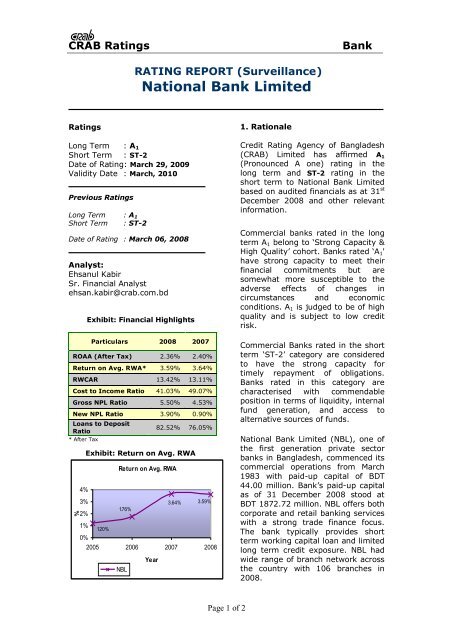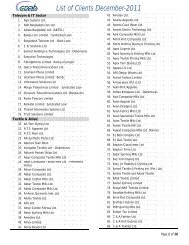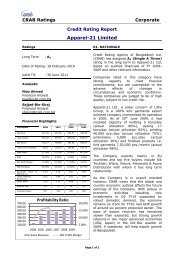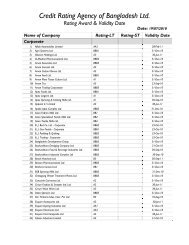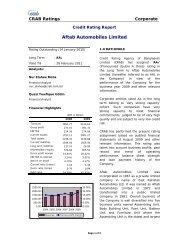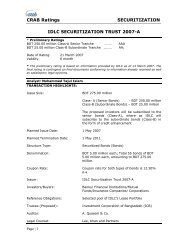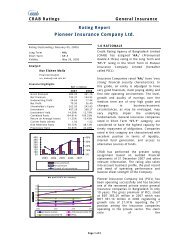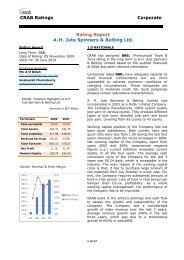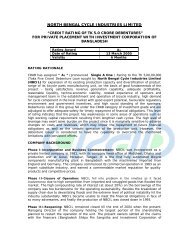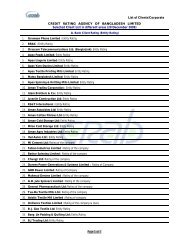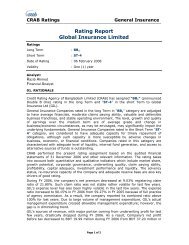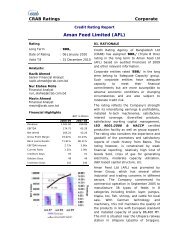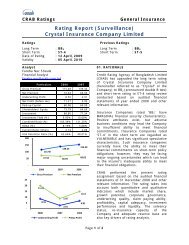National Bank Limited - Credit Rating Agency of Bangladesh
National Bank Limited - Credit Rating Agency of Bangladesh
National Bank Limited - Credit Rating Agency of Bangladesh
You also want an ePaper? Increase the reach of your titles
YUMPU automatically turns print PDFs into web optimized ePapers that Google loves.
%<br />
CRAB <strong>Rating</strong>s<br />
<strong>Bank</strong><br />
RATING REPORT (Surveillance)<br />
<strong>National</strong> <strong>Bank</strong> <strong>Limited</strong><br />
<strong>Rating</strong>s<br />
Long Term : A 1<br />
Short Term : ST-2<br />
Date <strong>of</strong> <strong>Rating</strong>: March 29, 2009<br />
Validity Date : March, 2010<br />
Previous <strong>Rating</strong>s<br />
Long Term : A 1<br />
Short Term : ST-2<br />
Date <strong>of</strong> <strong>Rating</strong> : March 06, 2008<br />
Analyst:<br />
Ehsanul Kabir<br />
Sr. Financial Analyst<br />
ehsan.kabir@crab.com.bd<br />
Exhibit: Financial Highlights<br />
Particulars 2008 2007<br />
ROAA (After Tax) 2.36% 2.40%<br />
Return on Avg. RWA* 3.59% 3.64%<br />
RWCAR 13.42% 13.11%<br />
Cost to Income Ratio 41.03% 49.07%<br />
Gross NPL Ratio 5.50% 4.53%<br />
New NPL Ratio 3.90% 0.90%<br />
Loans to Deposit<br />
Ratio<br />
* After Tax<br />
4%<br />
3%<br />
2%<br />
82.52% 76.05%<br />
Exhibit: Return on Avg. RWA<br />
Return on Avg. RWA<br />
1.76%<br />
3.64%<br />
3.59%<br />
1%<br />
1.20%<br />
0%<br />
2005 2006 2007 2008<br />
NBL<br />
Year<br />
1. Rationale<br />
<strong>Credit</strong> <strong>Rating</strong> <strong>Agency</strong> <strong>of</strong> <strong>Bangladesh</strong><br />
(CRAB) <strong>Limited</strong> has affirmed A 1<br />
(Pronounced A one) rating in the<br />
long term and ST-2 rating in the<br />
short term to <strong>National</strong> <strong>Bank</strong> <strong>Limited</strong><br />
based on audited financials as at 31 st<br />
December 2008 and other relevant<br />
information.<br />
Commercial banks rated in the long<br />
term A 1 belong to ‘Strong Capacity &<br />
High Quality’ cohort. <strong>Bank</strong>s rated ‘A 1 '<br />
have strong capacity to meet their<br />
financial commitments but are<br />
somewhat more susceptible to the<br />
adverse effects <strong>of</strong> changes in<br />
circumstances and economic<br />
conditions. A 1 is judged to be <strong>of</strong> high<br />
quality and is subject to low credit<br />
risk.<br />
Commercial <strong>Bank</strong>s rated in the short<br />
term ‘ST-2’ category are considered<br />
to have the strong capacity for<br />
timely repayment <strong>of</strong> obligations.<br />
<strong>Bank</strong>s rated in this category are<br />
characterised with commendable<br />
position in terms <strong>of</strong> liquidity, internal<br />
fund generation, and access to<br />
alternative sources <strong>of</strong> funds.<br />
<strong>National</strong> <strong>Bank</strong> <strong>Limited</strong> (NBL), one <strong>of</strong><br />
the first generation private sector<br />
banks in <strong>Bangladesh</strong>, commenced its<br />
commercial operations from March<br />
1983 with paid-up capital <strong>of</strong> BDT<br />
44.00 million. <strong>Bank</strong>’s paid-up capital<br />
as <strong>of</strong> 31 December 2008 stood at<br />
BDT 1872.72 million. NBL <strong>of</strong>fers both<br />
corporate and retail banking services<br />
with a strong trade finance focus.<br />
The bank typically provides short<br />
term working capital loan and limited<br />
long term credit exposure. NBL had<br />
wide range <strong>of</strong> branch network across<br />
the country with 106 branches in<br />
2008.<br />
Page 1 <strong>of</strong> 2
CRAB <strong>Rating</strong>s<br />
<strong>Bank</strong><br />
Net interest income dominated the revenue stream with 41% <strong>of</strong> total income.<br />
Other key sources <strong>of</strong> revenue were commission and exchange (29%) and interest<br />
income / dividend from investment (15%). NBL’s cost to income ratio reduced by<br />
8.04 percentage points and stood at 41.03%. NBL managed to restrict its<br />
operating expense even increasing staff expenses (by 11.88%) mainly because <strong>of</strong><br />
8.38% decline in other operating expenses.<br />
The bank’s net pr<strong>of</strong>it after tax has an increasing trend and stood at BDT<br />
1,516.68 million in 2008. Although ROAA before tax increased in 2008, after tax<br />
ROAA reduced marginally mainly because <strong>of</strong> higher growth in tax provision. NBL’s<br />
after tax return on risk weighted assets (RWA) also witnessed slight reduction in<br />
2008 and stood at 3.59% (2007: 3.64%).<br />
The bank is mainly funded by customer deposit and internal capital generation.<br />
About 30% <strong>of</strong> total deposits <strong>of</strong> the bank comprised current and savings deposits.<br />
But NBL enjoyed lower cost <strong>of</strong> deposits (6.76%) compared to PCB average<br />
(8.74% 1 ). The bank maintained satisfactory liquidity position in 2008. Loans and<br />
advances to deposit ratio <strong>of</strong> the bank was 82.52% at the end <strong>of</strong> 2008. The bank<br />
was the net lender to the call money market throughout 2008 except in May.<br />
NBL experienced substantial growth (36.16%) in loans and advances portfolio<br />
and reached at BDT 49,665.07 million by the end <strong>of</strong> 2008. The bank’s credit<br />
portfolio was reasonably diversified in terms <strong>of</strong> intrinsic and concentration risk.<br />
NBL’s loan portfolio in 2008 was dominated by local trade financing (32.02%)<br />
followed by import financing (20.46%). The bank’s top 50 funded loans advances<br />
in 2008 hold 35.83% (2007: 36.27%) <strong>of</strong> total loans and advances portfolio.<br />
The <strong>Bank</strong>’s gross non-performing loan (NPL) ratio in 2008 increased to 5.50%<br />
from 4.53% in 2007. Gross NPL ratio increased mainly because <strong>of</strong> higher growth<br />
in fresh NPL generation despite 36.16% growth in loans and advances. It is to be<br />
mentioned that apart from cash recovery, the bank had written <strong>of</strong>f BDT 472.78<br />
million and rescheduled BDT 151.30 million to reduce its closing NPL balance in<br />
2008. Special Mention Accounts (SMA) to total loans & advances ratio <strong>of</strong> the <strong>Bank</strong><br />
reduced to 1.97% in 2008 (2007: 2.16%).<br />
The <strong>Bank</strong> is reasonably capitalized with risk weighted capital adequacy ratio<br />
13.42% by the end <strong>of</strong> 2008 (2007:13.11%) against regulatory requirement 10%.<br />
The <strong>Bank</strong> increased its capital adequacy ratio to hold adequate capital in as per<br />
regulatory requirement which is to be attained by June 2011. Risk weighted<br />
assets to total assets ratio increased to 67.26% in 2008 (2007: 63.58%) which<br />
indicated that the bank had invested in more risky assets in 2008.<br />
NBL’s investment portfolio comprised government securities, quoted and<br />
unquoted shares, debentures, fixed capital investment in Myanmar as well as<br />
investment in NBL capital market service (CMS) fund. The bank invested BDT<br />
1000 million with CMS. But NBL did not classify the margin loans based on<br />
outstanding period. Moreover, the bank does not have any provision policy for<br />
margin loan loss.<br />
NBL has its strength in liquidity position and capital generation. On the other<br />
hand, principal concern for the bank is higher growth in non performing loans.<br />
NBL also lacks IT infrastructure for centralised MIS support.<br />
1 As on September 2008<br />
Page 2 <strong>of</strong> 2


